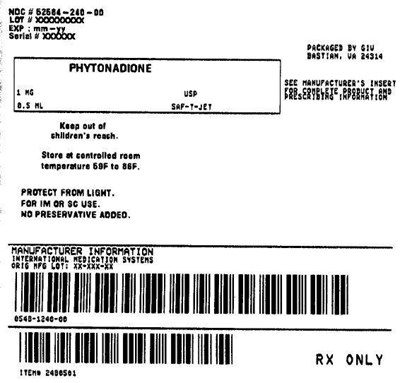Product Images Phytonadione
View Photos of Packaging, Labels & Appearance
Product Label Images
The following 5 images provide visual information about the product associated with Phytonadione NDC 52584-240 by General Injectables & Vaccines, Inc, such as packaging, labeling, and the appearance of the drug itself. This resource could be helpful for medical professionals, pharmacists, and patients seeking to verify medication information and ensure they have the correct product.
Image1.jpg - Image1

This text provides dosage information for the treatment of hemorrhagic disease in newborns, anticoagulant-induced prothrombin deficiency, and hypoprothrombinemia due to various other causes. The recommended dosage for newborns is either 0.5-1mg IM within the first hour of birth or 1mg SC or IM depending on whether the mother has been receiving oral anti-coagulants. For anticoagulant-induced prothrombin deficiency, the recommended dosage for adults is 25mg-10 mg, with higher doses potentially required for oral anti-coagulant users. Hypoprothrombinemia due to other causes may require doses of 25mg-25mg or more, rarely up to 50 mg.*
Image3.jpg - Image3

This text provides information about the 1M Saf-T-Jet "Safety Needle" user guide, which is likely a document with instructions and guidelines for using the needle safely.*
Label1.jpg - Label1

This appears to be a label or packaging information for a medicine named "PHYTONADIONE". It recommends checking the manufacturer's insert before taking it, and warns to keep it out of children's reach. It also specifies the temperature range to store the medicine and to protect it from light. Additionally, it specifies that it is for "IM or SC Use" and that no preservative is added. The rest of the text seems like product identification codes and might not have much relevant information.*
* The product label images have been analyzed using a combination of traditional computing and machine learning techniques. It should be noted that the descriptions provided may not be entirely accurate as they are experimental in nature. Use the information in this page at your own discretion and risk.

